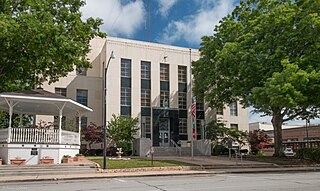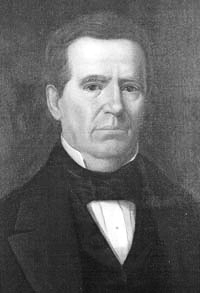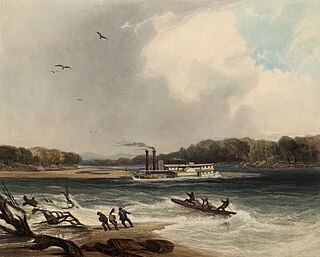
The Republic of Texas was a sovereign state in North America that existed from March 2, 1836, to February 19, 1846. It shared borders with Mexico, the Republic of the Rio Grande, and the United States of America.

Washington County is a county in Texas. As of the 2020 census, the population was 35,805. Its county seat is Brenham, which is located along U.S. Highway 290, 72 miles northwest of Houston. The county was created in 1835 as a municipality of Mexico and organized as a county in 1837. It is named for George Washington, the first president of the United States.

Navasota is a city primarily in Grimes County, Texas, United States. The population was 7,643 at the 2020 census. In 2005, the Texas Legislature designated Navasota as the "Blues Capital of Texas" in honor of the late Mance Lipscomb, a Navasota native and blues musician. Technically, a sliver of Navasota is in Brazos County, which is part of the Bryan-College Station Metropolitan area.

The Brazos River, called the Río de los Brazos de Dios by early Spanish explorers, is the 14th-longest river in the United States at 1,280 miles (2,060 km) from its headwater source at the head of Blackwater Draw, Roosevelt County, New Mexico to its mouth at the Gulf of Mexico with a 45,000-square-mile (116,000 km2) drainage basin. Being one of Texas' largest rivers, it is sometimes used to mark the boundary between East Texas and West Texas.

Anson Jones was a doctor, businessman, member of Congress, and the fourth and last president of the Republic of Texas.

The president of the Republic of Texas was the head of state and head of government while Texas was an independent republic between 1836 and 1845. The president served as the commander-in-chief of the Texas Military Forces.

Chappell Hill is an unincorporated community in the eastern portion of Washington County, Texas, United States. It is located inside Stephen F. Austin's original colony, and the land is some of the oldest Anglo-settled in the state. According to the Handbook of Texas, the community had a population of 600 in 2000. It is located within the Greater Houston metropolitan area.

Area code 979 is a telephone area code in the North American Numbering Plan (NANP) for the U.S. state of Texas. The numbering plan area comprises the region generally following the Brazos River found between the Austin and Houston metro areas and its surrounding communities, stretching from just south of Waco to the Gulf Coast. It was created on February 13, 2000, in a split from area code 409.

The Grand Lodge of Texas, Ancient Free and Accepted Masons is the largest of several governing bodies of Freemasonry in the State of Texas, being solely of the Ancients' tradition and descending from the Ancient Grand Lodge of England, founded on 17 June 1751 at the Turk's Head Tavern, Greek Street, Soho, London. According to historian James D. Carter, the "Grand Lodge of the Republic of Texas, A.F. & A.M." was founded on 16 April 1838. However, its first Grand Master and other grand officers were installed by Sam Houston on 11 May 1838. The Grand Lodge of Texas is one of the largest in the world, reporting 69,099 members in 2019. The current Grand Lodge of Texas facilities were made possible by the fundraising efforts of Waco Masonic Lodge No. 92.
Samuel Rhoads Fisher was the secretary of the Navy of the Republic of Texas.

State Highway 105 is a state highway in the U.S. state of Texas that runs from Brenham to the outskirts of Beaumont. The route was originally proposed in 1925 and took its current routing in 1984.

Iola is a city in Grimes County, Texas, United States, on Farm to Market Road 39 and the Burlington-Rock Island Railroad, at the headwaters of Ragan Creek in northwestern Grimes County. As of the 2010 census the population was 401.
Asa Brigham was a Texas politician, businessman and signer of the Texas Declaration of Independence (1836), which declared independence from Mexico. He served as Texas Treasurer and mayor of Austin, Texas.
The Texan schooner Independence was one of the four schooners of the First Texas Navy (1836–1838). At the direction of Texas Governor Henry Smith, in 1836 Charles Hawkins took command of United States revenue cutter Ingham acquired by the Texas Navy and renamed Independence.
Jesse Grimes (1788–1866) was a Texas pioneer and politician. Before moving to Texas, he fought in the War of 1812. He was a signer of the Texas Declaration of Independence. He served as Senator in the Republic of Texas Congress and in the Texas State Legislature. Grimes County was named in his honor.

The Star of the Republic Museum, in Washington, Texas, United States, is the only museum in the state of Texas created specifically to collect and interpret the culture and history of the Republic of Texas from 1836 to 1846. Within the museum's two floors of exhibits, visitors can learn about the history of the time period through media experiences, as well as informative exhibits. The site of the Star of the Republic Museum was selected at Washington on the Brazos where elected delegates gathered on March 2, 1836, to declare Texas’ independence from Mexico.

The steamboat Yellowstone was a side wheeler steamboat built in Louisville, Kentucky, for the American Fur Company for service on the Missouri River. By design, the Yellowstone was the first powered boat to reach above Council Bluffs, Iowa, on the Missouri River achieving, on her maiden voyage, Fort Tecumseh, South Dakota, on June 19, 1831. The Yellowstone also played an important role in the Texas Revolution of 1836, crossing the Texas Army under Sam Houston over the swollen Brazos River ahead of Santa Anna's pursuing Mexican Army.

Holland Lodge No. 1 AF&AM is the oldest Masonic lodge in Texas and a founding subordinate chapter of the Grand Lodge of Texas. The lodge was originally chartered by the Grand Lodge of Louisiana on 27 January 1836, making it older than the Republic of Texas. It is in the Museum District of Houston, Texas at 4911 Montrose Boulevard. The building was erected in 1954, designed by architect Milton McGinty. The sandstone mural facade depicting the origins of Freemasonry was carved by William M. McVey.

The Washington-on-the-Brazos State Historic Site is a historic site at Washington-on-the-Brazos, Texas, where the Convention of 1836 adopted the Texas Declaration of Independence. The government of Texas purchased 50 acres (20 ha) of the old townsite in 1916 and built a replica of the building where the delegates met. The state acquired more of the site in 1976 and 1996.

District 12 is a district in the Texas House of Representatives. It was created in the 3rd legislature (1849–1851).






























